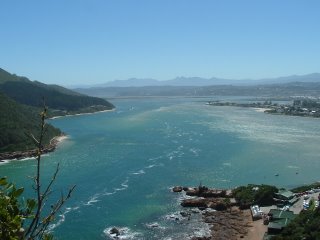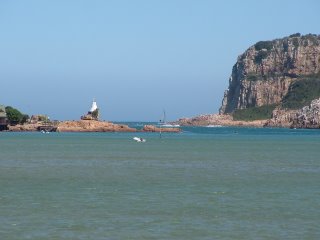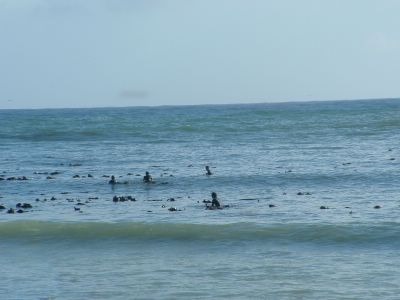 Knysna Lagoon
Knysna LagoonKnysna is built on the banks of the Knysna lagoon.
As the lagoon is tidal the sea water flows in and out of the lagoon through the Knysna Heads which are two large cliffs on either side of a 100 metre channel that was formed when a combination of sea and rivers cut a channel through the rocky coastline.
The channel is navigable for smaller ships and the navy regularly enters the lagoon with its frigates during the oyster festival which is held in July.
Shipping entering the lagoon has to be extremely careful as there is a large rock in the middle of the channel which they have to navigate around.
Over the years a number of ships have run aground on the rock and their remains lay strewn along the bottom of the channel.
A diving school at the Heads regularly dives in the channel to inspect the wrecks and to spear fish.
Fishing off the rocks in the vicinity of the Heads is good especially on a rising tide when fish enter the lagoon.
 The channel through the heads
The channel through the headsThe two heads have been developed differently.
The eastern head which can be reached by road has been developed into a residential area while the western head has been turned into a private nature reserve.
On the eastern head a number of lookout points have been built giving visitors a fantastic view over Knysna and the lagoon.
The lookout points on the sea side hang over the cliff face with a sheer drop of about 120 metres to the sea far below.
Scary stuff for those scared of heights.
The nature reserve on western head is called the Feather Bed Nature Reserve and is owned by William Smith son of J B Smith the man who discovered the Coelacanth in South Africa.
One can visit the Nature Reserve by booking a ticket on old four legs, a pleasure craft used by the Smiths to transport visitors across the lagoon to the Reserve.
Old four legs actually has four legs which are used to raise the vessel to the level of the fixed jetty on the nature reserve side of the channel.
If not for the legs passengers would not be able to get off the ferry at low tide.
After your excursion across the lagoon its time to explore the waterfront area.
The waterfront is a marina which is built on the banks of the lagoon opposite the heads and consists of a shopping centre, restaurants and residential flats.
Canals have been built between the buildings to form the marina.
There is a small drawbridge which is raised to allow yachts into the marina area so that one can park ones boat and car quite close to one another.
A small boat harbour has been built near the channel into the marina and many yachts and pleasure craft are moored there.
 The Outeniqu Choo Choo
The Outeniqu Choo ChooClose by is the Knysna railway station where one can board the world famous Outeniqua Choo Choo, one of the last scheduled steam train services in South Africa.
This train crosses the lagoon and puffs its way along the coast through Sedgefield and around the lakes to the Wilderness.
After stopping at the Wilderness station it crosses the Kaaimans River bridge with the sea breaking round the pillars of the bridge far below and then enters a short tunnel before making its way inland to George.
There is a surprise waiting for steam train enthusiasts when they arrive in George.
The Choo Choo does not go to the regular George station but pulls into a station at the entrance to the SA Railway Museum.
The museum covers the history of the railways in South Africa and has a number of old steam trains on display together with many smaller items which were once used on the trains to entertain passengers.
A visit to the museum is recommended.
Knysna is a lovely holiday destination in the middle of the sunshine coast and Tsitsikamma area.
It is not to be missed.
Turtle SA can arrange tours for you to this area.
To contact us send us an email to
TourinfoWe look forward to hearing from you.
Geoff Fairman Cape Peninsula Tours















